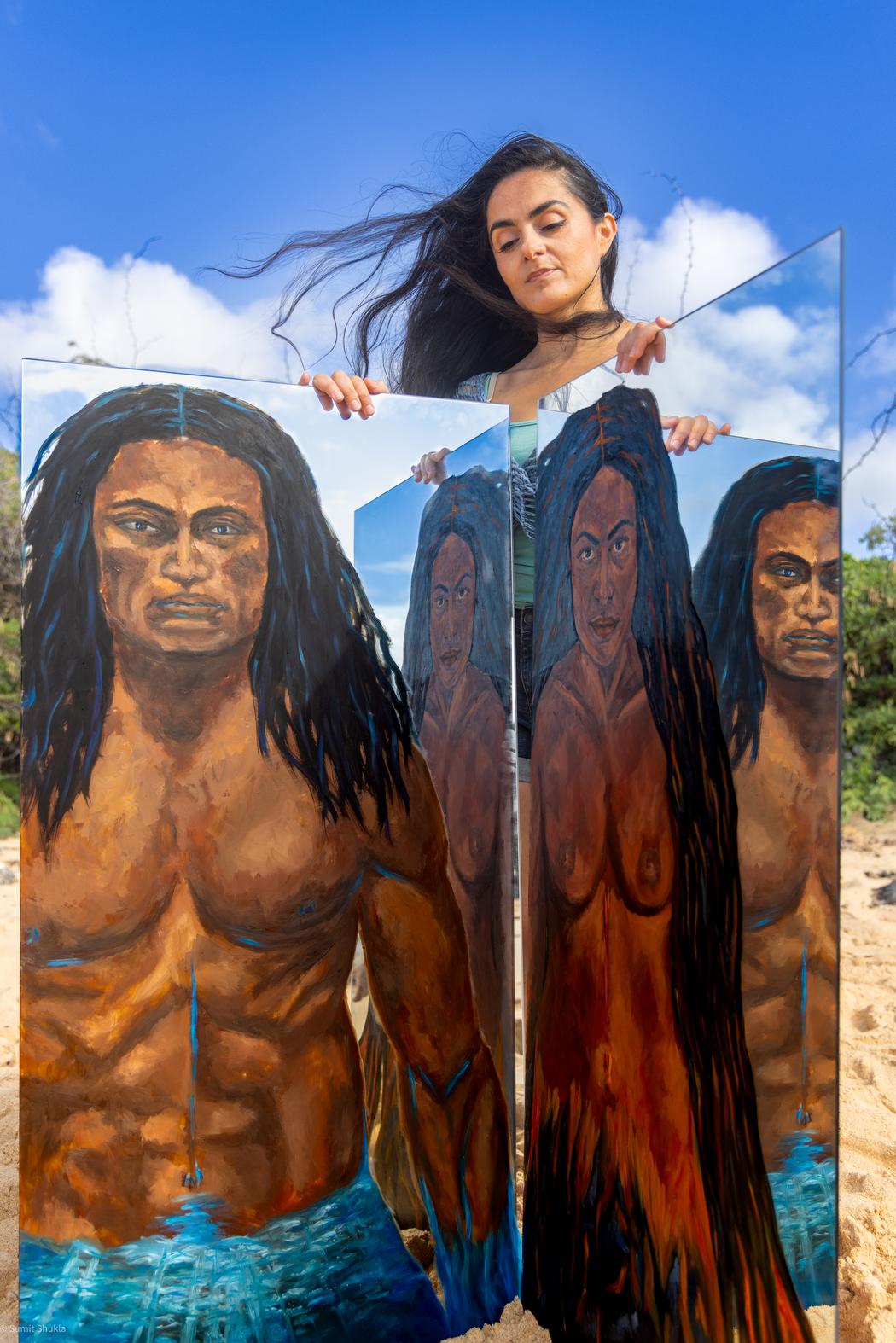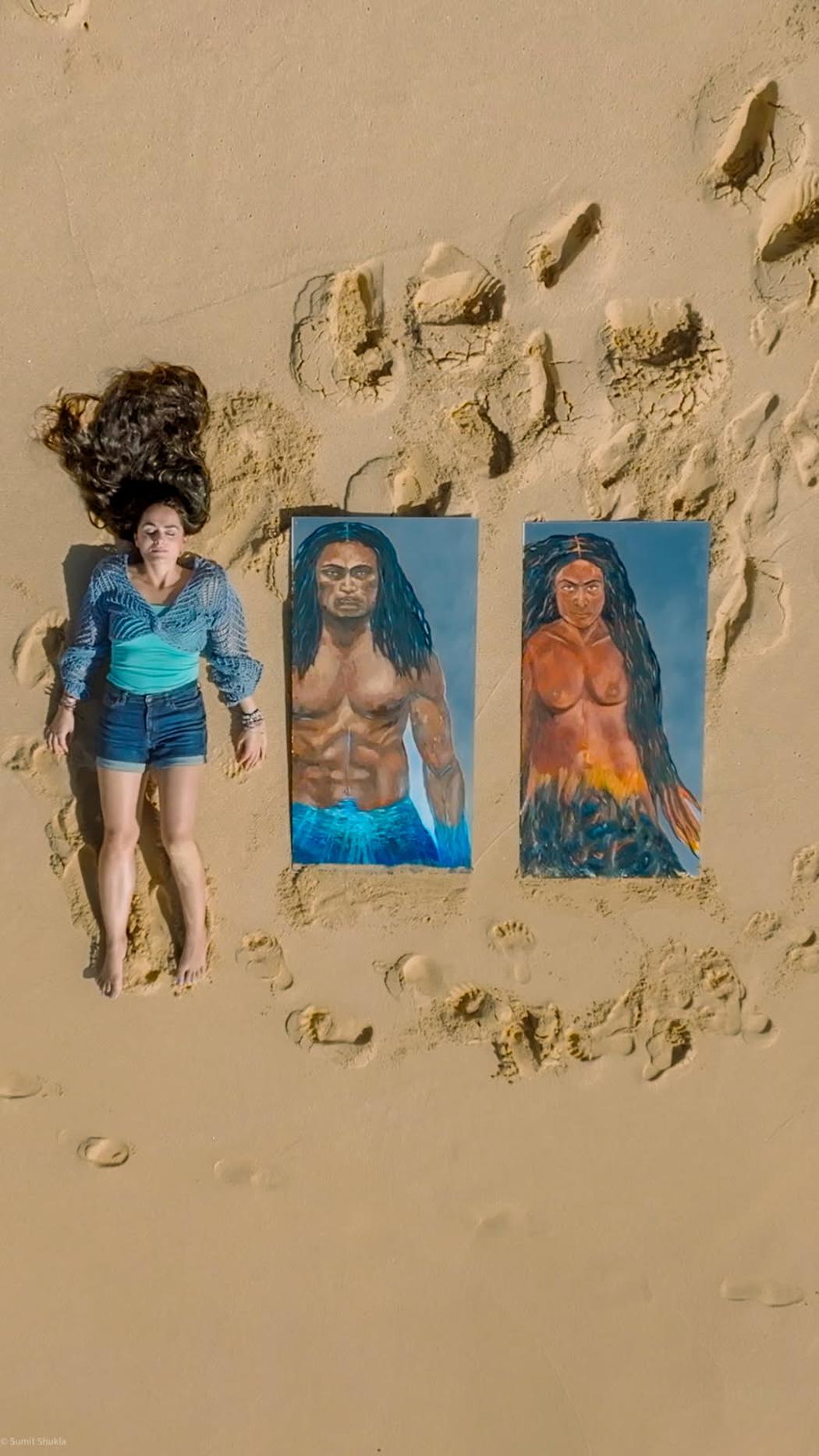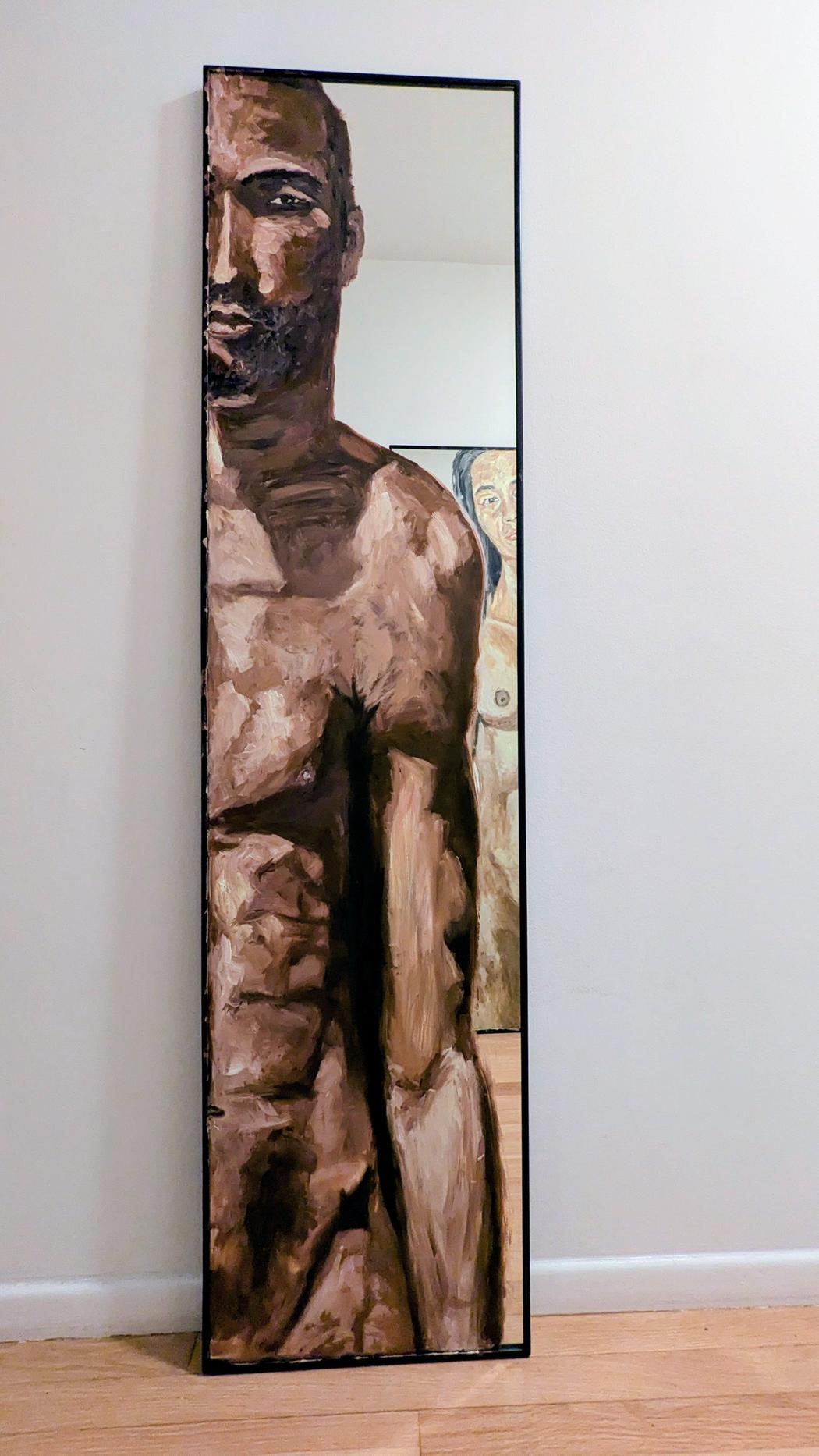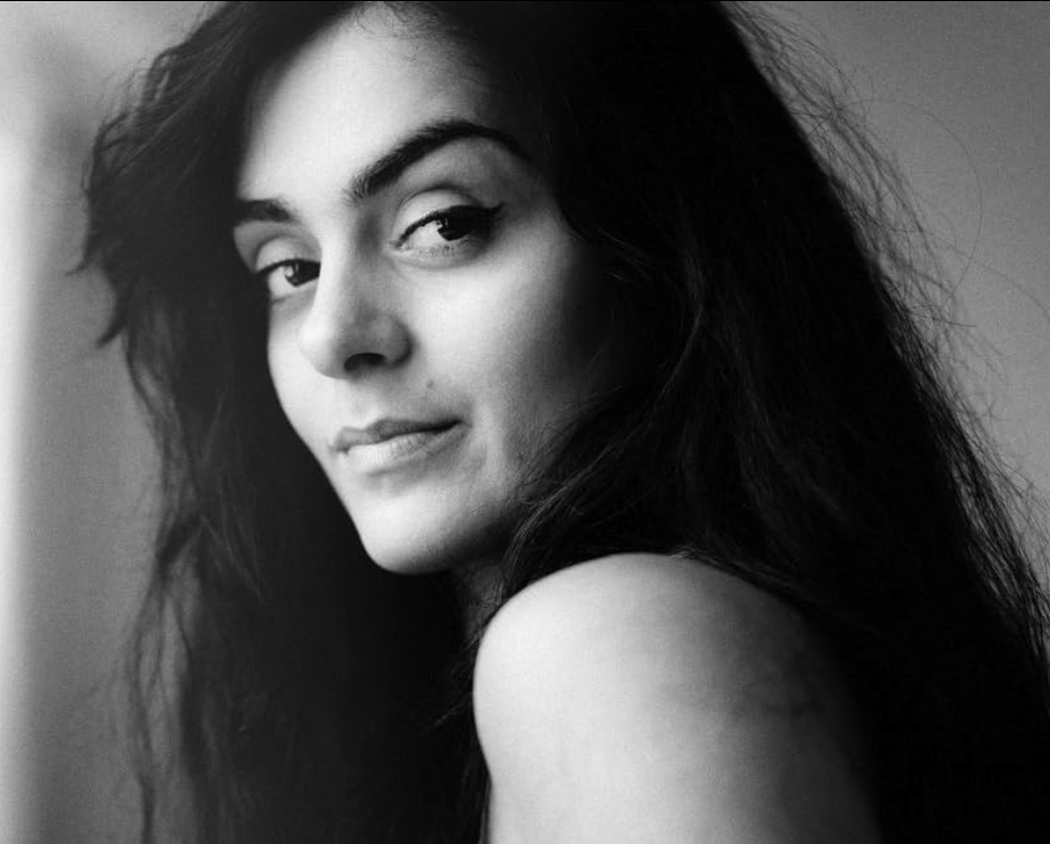Samara Couri
Your mirror paintings are incredibly striking. What initially inspired you to start painting on mirrors instead of traditional canvas?
My inspiration to work with mirrors stems from my fascination with film. I love how viewers can become absorbed in a scene or a moment between characters—how we sometimes resonate with the story or see different perspectives. Film is a medium of movement, and I sought that immersive experience in my art. I love painting on canvas and other surfaces but it wasn’t quite capturing what I had in my thoughts and vision. As I was reflecting on this, I looked up at a mirror on my wall and it was then that everything clicked and I could see that vision come to life. Mirrors provide an experience of creating a scene and inviting viewers to become part of it, one way or another.
In your “Akua, Hawaiian Deities” series, you collaborate with cultural practitioners. How did this collaboration begin, and how does it inform your creative process?
This collaboration has been essential to my work and started after a short time being on the island, learning the different cultural practices and pursuing the importance of spreading that knowledge. It has opened a vast world of learning about the islands’ ways of life, beliefs, and spirituality, especially the ongoing fight for self-governance and self-determination championed by grassroots group Ka Lāhui Hawai’i. They tirelessly address critical issues in Hawai’i, such as environmental disasters caused by the U.S. Navy—most notably the Red Hill water crisis—and organize protests to prevent the exploitation of sacred lands like Mt. Ka’ala, which is under threat from plans to build tourist attractions like gondola zip lines. These ventures prioritize profit over the wellbeing of Indigenous people and the land, which holds deep sacred and historical significance. With so much land and rights already lost, the greed from outsiders seems limitless. It’s vital to educate oneself about these realities and not treat the islands as a playground. These are serious issues that Hawaiians face daily while fighting to protect their home under difficult circumstances. For those interested, please visit www.kalahuihawaii.net to learn more and support their cause.
Working closely with Kumu ‘A’ai’i—a Hawaiian Cultural Practitioner, a Kumu Hula (Hula teacher), and Kapa Maker amongst many other gifts she has and does—has deeply enriched my understanding of the islands’ philosophies, culture, and history, especially the true meaning of Akua and the interconnectedness of all things. She is also my oli (chant) teacher, guiding me through the powerful and precise art of chanting, where vibration, pronunciation, and execution are critically important. There is a chant for almost everything, further reinforcing connection. I feel I’ve only begun to scratch the surface of this knowledge, which is deeply rooted in the people, and I am committed to continually learning and faithfully representing these emotions and studies in my work.

How do you approach the responsibility (kuleana) of representing Hawaiian culture as someone from outside the islands?
My kuleana begins with the understanding that I am a guest on the island—something that’s essential to acknowledge, especially given Hawai‘i’s history. As a guest, I strive to learn as much as I can and actively engage in cultural practices, whether through dance, oli (chant), or volunteering at beach clean-ups. This continuous learning is important because my work centers on Hawai‘i and its people as a form of giving back and showing respect. I deeply empathize with the causes being fought for here. Hawai‘i is a sacred and unique place, and it’s essential to genuinely honour my role within it.
What do you hope viewers feel or experience when they see themselves reflected in your work?
My work is an immersive experience, one I hope viewers find engaging and exciting as they explore multiple physical perspectives and angles. This dynamic interaction often introduces a psychological dimension, prompting viewers to become aware of their own presence and thoughts in relation to the work.
It reflects the ever-changing nature of identity—there’s always something new to discover and learn about ourselves and others. This awareness calls for openness to whatever we encounter, while also recognizing that change can happen at any moment, and we have the free will to respond. If you catch something in your reflection within the pieces, what will you do with it? Will you explore it further or leave it behind? Perhaps it becomes a tool for healing and prepares you for personal transformation. Often, it’s the subtle aspects of identity that make the greatest impact.
 Samara Couri | Respecting The Elements
Samara Couri | Respecting The Elements
Many of your figures have a strong and powerful presence. Can you share more about the emotions or energies you aim to capture in them?
There’s a particular look or expression I try to bring out in each figure. There’s always a narrative—one that exists within the piece, but that can shift depending on the viewer’s perspective. I aim to capture a look that invites deeper thought and creates a sense of openness between the figure and the viewer. When I paint the figure—especially the face and eyes—there’s a clear intention behind how I apply and express the paint. I want that intention to translate into a specific thought, feeling, or subject the viewer can engage with.
Your work creates a “psychological hall of mirrors.” What role does introspection play in your art?
I invite introspection by creating spaces where viewers feel safe to connect in their own way. In many ways, the pieces become theirs in that moment—open to personal interpretation, feelings, and thoughts about what may unfold. This immersive experience between viewer and artwork creates a unique connection and layers of meaning. It might remain a private dialogue or become something they share with others, perhaps opening an entirely new world they hadn’t noticed before.
 Samara Couri | You See Me
Samara Couri | You See Me
How has living in Hawai’i influenced your artistic vision and practice?
Living in Hawai’i has awakened a deep consciousness in me about the islands’ history, which informs much of my work. The Kingdom of Hawai’i was overthrown and illegally taken. This history remains central to many Kanaka Maoli (Indigenous peoples of Hawai’i), who strive to have their voices heard and their culture and language preserved after years of suppression. For me, being here means being mindful of this legacy and engaging however I can—through learning the language, hula, oli (chant), and more—to show respect and help ensure these traditions are not forgotten, and that sovereignty remains a possibility. Hawaii’s rich and profound culture is deeply moving, making it impossible not to connect. Therefore, my work reflects my care for the islands, its people, their beliefs, and their causes. Living here is not just about oneself but about truly connecting and opening up that world, hence involving the viewer directly in the subject.
What has been the most meaningful response or interaction someone has had with your mirror paintings?
I’ve had many people open up to me in very personal ways. They often come in without knowing what to expect and sometimes spend quite a while engaging with the mirror paintings—looking through and around them, even returning on another day to try to better understand their own emotions and thoughts. The work seems to open something inside them, as if they’ve been seen in a way they hadn’t experienced before, which helps them feel safe and able to trust the space.
They open up about personal struggles, relationships, and much more. It’s incredibly fascinating to witness this, and it means so much to me, because the work then takes on a life of its own—becoming emotionally available to the people who engage with it.


Leave a Reply